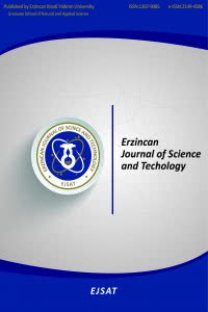Bir Nanoakışkanın Farklı pH Değerlerindeki Isı Transfer Katsayılarının Belirlenmesi ve Karar Ağacı Algoritması ile Modellenmesi
Nanoakışkan, Nanomalzeme, Isı transfer katsayısı, Karar ağacı
Determination of Heat Transfer Coefficients at Different pH Values of a Nanofluids and Modeling with Decision Tree Algorithm
Nano fluid, Nano material, Heat transfer coefficient, Decision tree,
___
- Maxwell J. C., A Treatise on Electricity and Magnetism, 1881. Second ed., Clarendon Press, Oxford, UK.
- Gürmen, S. Ebin, B., 2008. Nanopartiküller ve Üretim Yöntemleri-1, Metalurji Dergisi, 150, 31-38. Choi, S.U.S., 1995. Enhancing thermal conductivity of fluids with nanoparticles, The Proceedings of the 1995 ASME International Mechanical Engineering Congress and Exposition, San Francisco, USA, ASME, FED 231/MD 66, 99–105.
- Xu J.F., Zhang J.R., Du Y.W., 1996, Ultrasonic velocity and attenuation in nano- structured Zn materials, Mater Lett; 29, 131–4.
- Verma P., Chaturvedi P., Rawat J.S.B.S., 2007. Elimination of currentnon-uniformity in carbon nanotube field emitters, J Mater Sci: Mater Electron, 18, 677–80.
- Fotukian, S.M., Esfahany, M.N., 2010. Experimental study of turbulent convective heat transfer and pressure drop of dilute CuO/water nanofluid inside a circular tube, Int. Commun. Heat Mass Trans, 37, 214-219.
- Wang, X., Xu, X., Choi, S.U.S., 1999. Thermal conductivity of nanoparticle-fluid mixture. J. Thermophys Heat. Transf, 13(4), 474–480.
- Pak, B.C., Cho, Y.I., 1998. Hydrodynamic and heat transfer study of dispersed fluids with submicron metallic oxide particles, Exp. Heat Transf Int. J., 11(2), 151–170.
- Eastman, J. A., Choi, S. U. S., Li, S., Yu,W., Thompson, L. J., 2001. Anomalously Increased Effective Thermal Conductivity of Ethylene Glycol-Based Nanofluids Containing Copper Nanoparticles, Applied Physics Letters, 78, 718–720.
- Xuan Y., Li Q., 2000. Heat transfer enhancement of nanofluids, International Journal of Heat and Fluid Flow, 21(1), 58–64.
- XuanY., Li Q., Hu W., 2003. Aggregation Structure and Thermal Conductivity of Nanofluids, AIChE Journal, Cilt 49, No 4, 1038-1043.
- Zhou, L.,P, Wang, B.X., Peng, X.,F, Du, X-Z, Yang, Y.P., 2010. On the specific heat capacity of CuO nanofluid. Adv Mech Eng, 172085, 1–4.
- Williams, W., Buongiorno, J., Hu, L.W., 2008. Experimental investigation of turbulent convective heat transfer and pressure loss of alumina/water and zirconia/ water nanoparticle colloids (nanofluids) in horizontal tubes, J. Heat Trans, 130, 042412.
- Fakoor, Pakdaman M., Akhavan-Behabadi M.A., Razi, P., 2012. An experimental investigation on thermo-physical properties and over all performance of MWCNT/ heat transfer oil nanofluid flow inside vertical helically coiled tubes, Exp Therm Fluid Sci 40(0),103–11.
- Sajadi, A. R., Kazemi, M. H., 2011. Investigation of turbulent convective heat transfer and pressure drop of TiO2/water nanofluid in circular tube. International Communications in Heat and Mass Transfer, 38(10), 1474-1478.
- Alade, I. O., Oyehan, T. A. et. al. 2018. Modeling thermal conductivity enhancement of metal and metallic oxide nanofluids using support vector regression, Advanced Powder Technology, vol.29(1), pp.157-167.
- Hemmati-Sarapardeh, A., Varamesh, A., Husein, M. M. and Karan, K., 2018. On the evaluation of the viscosity of nanofluid systems: Modeling and data assessment, Renewable and Sustainable Energy Reviews, vol.81, pp.313-329.
- Esfe, M. H. A.Tatar, Ahangar M.R.H. and Rostamian, H., 2018. A comparison of performance of several artificial intelligence methods for predicting the dynamic viscosity of TiO2/SAE 50 nano-lubricant, Physica E: Low-dimensional Systems and Nanostructures, vol. 96,pp. 85-93.
- Demirpolat, A.B. Das, M., 2019 Prediction of Viscosity Values of Nanofluids at Different pH Values by Alternating Decision Tree and Multilayer Perceptron Methods, Appl. Sci. vol.9, 1288.
- Afrand, M. A. Nadooshan, A. Hassani, M. Yarmand, H. and Dahari. M., 2016 Predicting the viscosity of multi-walled carbon nanotubes/water nanofluid by developing an optimal artificial neural network based on experimental data, International Communications in Heat and Mass Transfer, vol.77, pp.49-53.
- Ahmadi M. H., M. Ahmadi, A. Nazari M. A., Mahian O. and Ghasempour, R.,2019 A proposed model to predict thermal conductivity ratio of Al 2 O 3/EG nanofluid by applying least squares support vector machine (LSSVM) and genetic algorithm as a connectionist approach, Journal of Thermal Analysis and Calorimetry, vol.135(1), pp.271-281.
- Ahmadi, M. H., Tatar, A., Seifaddini P., et al. 2018. Thermal conductivity and dynamic viscosity modeling of Fe2O3/water nanofluid by applying various connectionist approaches, Numerical Heat Transfer, Part A: Applications, vol.74(6), pp.1301-1322.
- Gil, E. et. al. 2018. XPS and SEM analysis of the surface of gas atomized powder precursor of ODS ferritic steels obtained through the STARS route, Applied Surface Science, vol. 427: pp.182-191.
- Jothibas, M., Manoharan, C., Jeyakumar, S. J., Praveen, P., Punithavathy, I. K., & Richard, J. P. (2018). Synthesis and enhanced photocatalytic property of Ni doped ZnS nanoparticles. Solar Energy, 159, 434-443.
- Çengel Yunus A., 2010. Isı Ve Kütle Transferi Pratik bir Yaklaşım 3. Basım,467- 468.
- Safavian, S.R., Landgrebe, D., 1991. A survey of decision tree classifier methodology, IEEE Transactions on Systems Man and Cybernetics, vol. 21, pp.660-674.Pal, M., Mather, P.M., 2003. An assessment of the effectiveness of decision tree methods for land cover classification, Remote Sensing of Environment, vol.86, pp.554-565.
- Miller, J. C. Serrato, R. et.al., 2004. The Handbook of Nanotechnology, John Wiley & Sons, Inc., Hoboken, New Jersy.
- ISSN: 1307-9085
- Yayın Aralığı: 3
- Başlangıç: 2008
- Yayıncı: Erzincan Binali Yıldırım Üniversitesi, Fen Bilimleri Enstitüsü
Trombidioid (Acari: Parasitengona) Larva Derilerinin Değerlendirilmesi ve Teşhisteki Önemi
Robotik Total Station ve GNSS Ölçümlerinin Analizi
Bazı Temel Karbonhidratlar İçin Hızlı Nötron Zırhlama Parametrelerinin Hesaplanması
HÜLYA DURUR, MEHMET ŞENOL, Ali KURT, Orkun TAŞBOZAN
Serbest Nilpotent Lie Cebirlerinin Otomerkezi Otomorfizmleri
Bir Parametreli Eliptik Homotetik Düzlemsel Hareketler
Yrd. Doç. Dr. Ayşe Zeynep AZAK
HÜLYA DURUR, ORKUN TAŞBOZAN, ALİ KURT, MEHMET ŞENOL
Foto-kapan Görüntülerinde Hareketli Nesne Tespiti ve Konumunun Belirlenmesi
Emrah ŞİMŞEK, Özyer BARIŞ, Gülşah Tümüklü ÖZYER
Tec1 Transkripsiyon Faktörünün NTH1 Gen Ekspresyonuna Etkisi
